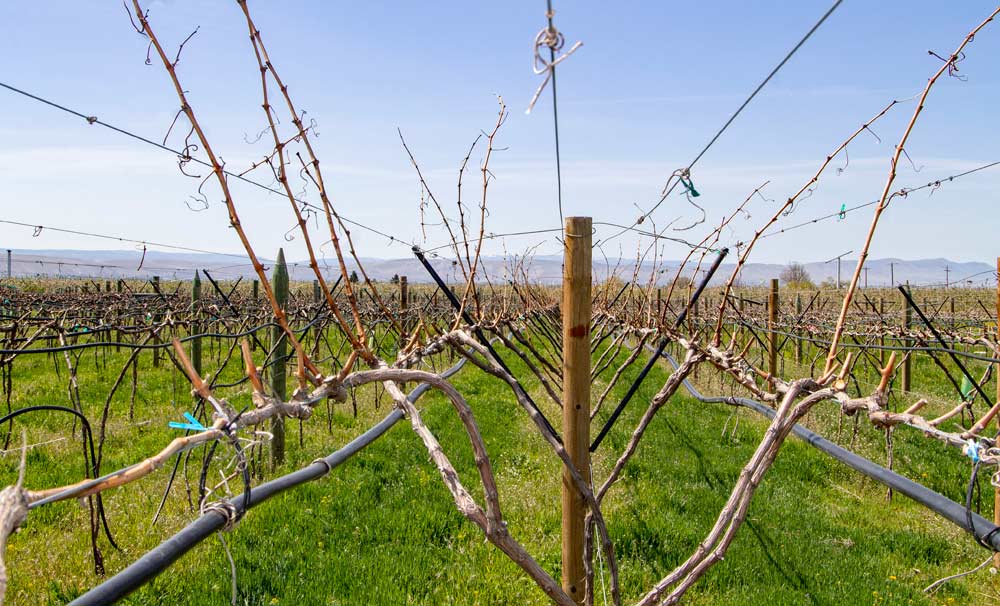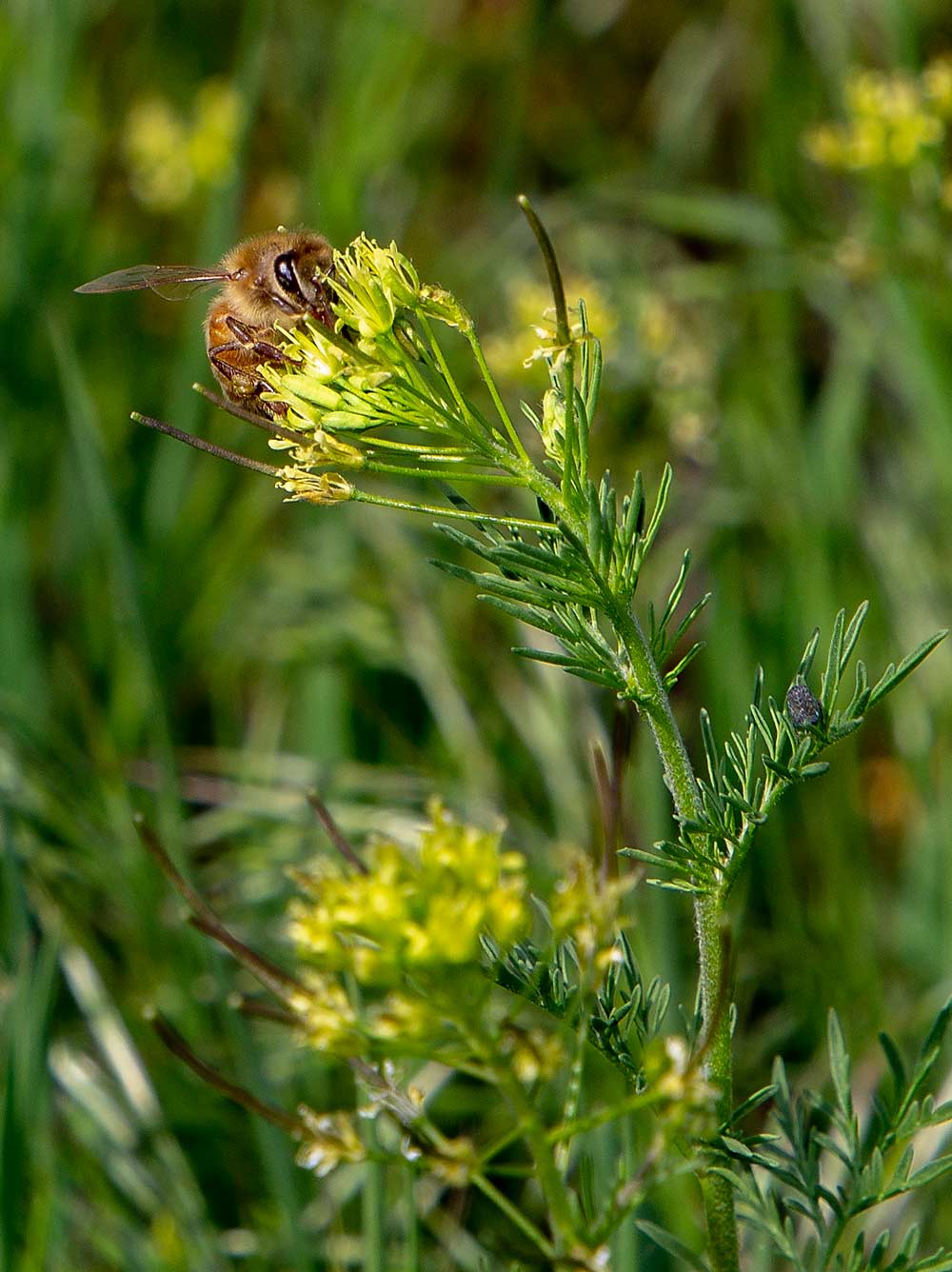
A divided trellis system that opens the canopy provides the core of Paul Vandenberg’s management system, like this 5th leaf cabernet that still has some canes left to serve as spares for new cuttings. The training system has enabled Vandenberg to reduce all pesticide inputs to zero in his small vineyard in Zillah, Washington on April 23, 2018. (Kate Prengaman/Good Fruit Grower)
Paul Vandenberg hasn’t sprayed a pesticide on his grapevines in five years. That’s no herbicides, insecticides or fungicides — even the organic certified ones — applied at the tiny Paradisos del Sol vineyard in Zillah, Washington.
The effort hasn’t been without casualties — Vandenberg ripped out most of his temperamental Tempranillo after high powdery mildew pressure proved disastrous last season — but on the whole, adapting his vineyard to fewer inputs has improved fruit quality.
But then he tells me I’ve got it backward.
“All of these things I do are focused on grape quality. It coincidentally has created an environment where we don’t have problems in a major way with pests,” said Vandenberg, who strives to maximize light interception in the several acres of grapes he grows for his boutique winery.
Some of his practices, such as mowing under the vine row with a weedwacker, would be totally impractical in a commercial vineyard, but Vandenberg believes much of his experience using canopy management to reduce pest pressure could translate to neighboring commercial operations in the Yakima Valley and other arid, sunny growing regions.

Paradisos del Sol owner Paul Vandenberg poses inside his V-trellised Chenin Blanc, which has not been sprayed in five years. (Kate Prengaman/Good Fruit Grower)
The heart of his management is a unique V-trellis system that divides the canopy and supports twice as many vines per acre as most plantings. This creates a very open canopy and supports two drip lines, hung wide on the arms of the V, which Vandenberg uses in an alternate root zone deficit system to keep canopy vigor low. The system — like a Geneva Double Curtain modified for upward growing wine grapes — was developed by University of California viticulturist Mark Kliewer in the 1980s, when Vandenberg was a student there.
“Mark Kliewer said that ‘I can build a trellis system that will increase yields by 50 percent, improve grape quality, and reduce the needs for inputs.’ I’ve found that it’s exactly true,” Vandenberg said. When he began planting this vineyard in the early 2000s, he copied the divided canopy trellis built by Prosser, Washington, growers Charlie and Connie Crawford.
The wide drip lines encourage vine roots to reach out into the row middles and keep the vineyard floor cover crop of mustards and cheat grass in a band alongside the vine row, rather than right under it; that makes weed control via mowing, not herbicides, easier.
“My view is that I’m able to use 100 percent of my soil,” he said, compared to conventional irrigation styles that keep roots in a narrower swath of soil. “I can’t help but think the larger the digestive system of the plant, the more access to more nutrients, the healthier the plant is going to be. We have a deep rich fertile soil and we are able to take advantage of it, but since we live in an arid climate, we can use deficit irrigation to control the growth.”
The alternate side deficit also helps to control most weeds, as anything that sprouts will have to survive at least two weeks before it gets watered again.
Last season’s high powdery mildew pressure presented the first major challenge to his no-spray system. Usually, powdery mildew only occurs in spots where the canopy has not been pruned properly to have 10 to 15 shoots per meter, a target Vandenberg sets depending on the leaf size of the variety.
“Every leaf gets direct sun, every cluster gets some direct sun, that’s why I don’t have a real problem with powdery mildew,” he said.
But leaves grew extra big last spring, challenging his typical canopy control targets, and the Tempranillo and Riesling crops suffered severely. Still, he opted not to spray stylet oil, his longstanding preference for cleaning up mildew.
“We decided that perhaps the value of being able to say this is a zero-pesticide vineyard exceeded the value of that couple tons of grapes,” he said. That said, Paradisos del Sol is still figuring out how to market this style of management to the right niche of consumers who will value it. The vineyard is also certified organic.

Mustards and cheat grass are not considered weeds at Paradisos del Sol, but Vandenberg credits his alternate root zone deficit irrigation system with making the vineyard floor easy to control with mowing, and the mustards bloom all season, luring a wide variety of beneficial insects. (Kate Prengaman/Good Fruit Grower)
People often ask him, this reporter included, how could these practices scale to a commercial vineyard? After all, most growers can’t afford to lose a crop to stick by a no-spray principal.
Vandenberg acknowledges that, “I’m a wine grower. I’m not selling grapes; I’m making wine,” and that changes the calculations somewhat. But larger vineyards could invest in an articulating mower to replace his weedwacker and high-end vineyards that already invest in a lot of hand labor could do similar canopy control work for disease management, he said.
“Is our zero-pesticide thing totally practical? No,” Vandenberg said. “But I think every grower can get something out of our system that will reduce their inputs or improve fruit quality.” •
—by Kate Prengaman






Leave A Comment